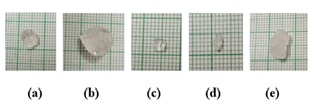Investigation of Functional Group, Optical and Structural Characteristics of Doped and Pure Glycine LiNO3 Crystals
DOI:
https://doi.org/10.61343/jcm.v3i01.120Keywords:
Grown from solution, Slow evaporation, Glycine LiNO3, XRD, FTIR, UV-vis SpectroscopyAbstract
Second Harmonic Generation (SHG) from the Centro-symmetric Glycine crystals in its pure form shows a photo-type of waves on resistance from the guest molecule. Such materials that are non-linear optical (NLO) have potential application in Second Harmonic Generation. An excellent optically transparent single crystal of Glycine in the presence of fractional amount of Lithium Nitrate, Potassium Nitrate and Sodium Nitrate are grown in a solution by slow evaporation method which have good nonlinear optical behavior. Powder X- ray diffraction spectrum were recorded using a diffractometer with Cu- Kα radiation, scanning in the 85 degree range for 8 minutes. The paper studies exhibit powder XRD pattern of the grown crystals after calculating lattice parameter values, particle size, dislocation density, strain values etc. The X-ray Diffraction studies shows that the crystalline perfection of grown crystals are extremely good with no internal structural grain boundaries. In order to investigate structural phase, presence of different chemical bonds or additional elemental group etc. Within grown crystals, they were examined by the spectrum of Fourier Transform Infrared (FTIR) spectroscopy. Assigned vibration of various chemical bond groups were identified and confirmed by this investigation. Optical Characteristics of Doped and Pure Glycine LiNO3 crystals were carried out by visible and ultraviolet (UV) spectra and band gap (Eg) of the synthesized sample were calculated. For a nonlinear application, it was determined that the optical transparency and cut off wavelength needed to be equals to 300 nm. For NaNO3 with concentration of 20% and 60% doping, the band gap was found as 6.07 eV and 5.84eV respectively. For KNO3doping with concentration of 20% and 60%, the energy band gap was found to be 6.21 eV and 5.88 eV respectively.
References
Narayan Bhat, M Dharmaprakash, S M J. Cryst. Growth, 236:376-380,2002.
Narayan Bhat, M Dharmaprakash, S M J. Cryst. Growth.235:511-516,2002.
P V Dhanaraj, T Suthan and N. P. Rajesh, Curr. Appl. Phys.10:1349-1353, 2010.
M E Peter and P Ramasamy, Mater. Lett.64:1-3, 2010.
M M Khandpekar and S P Pati, Opt. Commu. 283: 2700-2704,2010.
Mohd Shakir, S K Kushwaha, K K Maurya, Sumeet Kumar, M A Wahab and G Bhagavananarayan, J. Appl. Crystallogr.43:491-497,2010.
M E Peter and P Ramasamy, J. Cryst. Growth. 312:1952-1956,2010.
R Parimaladevi, C Sekar, Crystal Growth and Spectral Studies of nonlinear optical J- glycine single crystal grown from phosphoric acid, Spectrochimica Acta Part A 76: 490-495, 2010.
J Thomas Joseph Prakash, M Lawrence, J Felicita Vimala and M. Iyanar, Journal of Physical Science, Vol 14: 219-226, 2010.
C Murali, S Thomas, S Venkateshwarm and S M Sharma, Physics.364:233,2005.
M D Aggarwal, J Stephens, A K Batra and R B Lal, J Optoelectron. Adv. Mater,5:555,2003.
N Tyagi, N Sinha, B Kumar, Evidence of Sustained ferroelectricity in glycine sodium nitrate single crystal, Curr. Appl. Phy.14:156-160,2014.
V Ganesh, T Bhaskar Rao, K Kishan Rao,G Bhagavannarayana, Mohd Shakir,137:276-281,2012.
K Russelraj, P Murugakoothan, Mod.Phys.Lett. B,26, 2012.
M Arivazhagan, R Meenakshi, Spectrochim, Acta Part A 91:419-430,2012.

Downloads
Published
How to Cite
License
Copyright (c) 2025 Nimisha Agrawal, P R Vyas

This work is licensed under a Creative Commons Attribution 4.0 International License.
Copyright© by the author(s). Published by journal of Condensed Matter. This is an open access article distributed under the terms of the Creative Commons Attribution (CC BY) license (https://creativecommons.org/licenses/by/4.0/), which permits unrestricted use, distribution, and reproduction in any medium, provided the original author(s) and source are credited.









